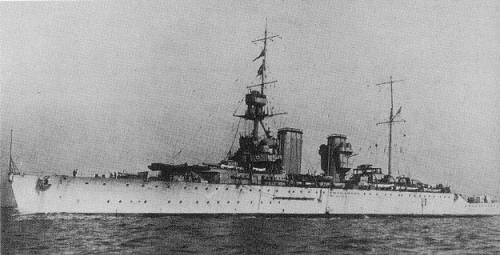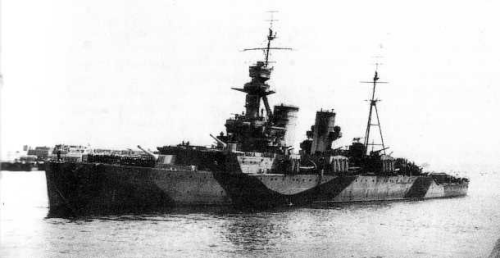
NAVYPEDIA
 Support the project with paypal
Support the project with paypal
Photo

Hawkins 1922
Ships
| Name | No | Yard No | Builder | Laid down | Launched | Comp | Fate |
|---|---|---|---|---|---|---|---|
| Hawkins | D86 | Chatham DYd | 3.6.1916 | 1.10.1917 | 7.1919 | sold for BU 8.1947 | |
| Raleigh | 551 | Beardmore, Dalmuir | 4.10.1916 | 28.8.1919 | 7/1921 | wrecked 8.8.1922 | |
| Frobisher | D81, 1948- C81 | Devonport DYd | 2.8.1916 | 20.3.1920 | 9.1924 | sold for BU 3.1949 | |
| Effingham | D98 | Portsmouth DYd | 2.4.1917 | 8.6.1921 | 7.1925 | wrecked 17.5.1940 |
Technical data
| Displacement normal, t | 9750 |
|---|---|
| Displacement full, t | 12110 - 12300 |
| Length, m | 184.4 |
| Breadth, m | 19.8 |
| Draught, m | 5.9 |
| No of shafts | 4 |
| Machinery | Hawkins: 4 sets Parsons geared steam turbines, 12 Yarrow boilers Raleigh: 4 sets Brown-Curtis geared steam turbines, 12 Yarrow boilers Effingham, Frobisher: 4 sets Brown-Curtis geared steam turbines, 10 Yarrow boilers |
| Power, h. p. | Hawkins: 60000 Raleigh: 70000 Effingham, Frobisher: 65000 |
| Max speed, kts | Hawkins: 30 Raleigh: 31 Effingham, Frobisher: 30.5 |
| Fuel, t | Hawkins, Raleigh: oil 1480 + coal 860 Frobisher, Effingham: oil 2150 |
| Endurance, nm(kts) | Hawkins, Raleigh: 5400(14) Effingham, Frobisher: 7000(15) |
| Armour, mm | belt: 76 - 38, deck: 38 - 25, bulkheads: 25, gun houses: 51, magazines: 25, CT: 76 |
| Armament | Hawkins: 7 x 1 - 190/45 BL Mk VI, 6 x 1 - 76/50 12pdr 18cwt QF Mk I, 4 x 1 - 76/45 20cwt QF Mk I, 4 x 1 - 47/40 3pdr Hotchkiss Mk I, 2 x 1 - 40/39 QF Mk II, 6 - 533 TT (beam) Raleigh: 7 x 1 - 190/45 BL Mk VI, 4 x 1 - 76/45 20cwt QF Mk I, 2 x 1 - 40/39 QF Mk II, 6 - 533 TT (beam) Frobisher, Effingham: 7 x 1 - 190/45 BL Mk VI, 3 x 1 - 102/45 QF Mk V, 2 x 1 - 40/39 QF Mk II, 6 - 533 TT (beam) |
| Complement | 712 |
Standard scale images

Frobisher 1942

Effingham 1940

Frobisher 1943

Frobisher 1924
Graphics
Project history
A new class of cruisers was designed in 1915 to meet the threat of armed raiders in distant oceans, for the effort to hunt down the small number of German cruisers in August-December 1914 had seriously depleted the Grand Fleet's light cruiser squadrons and had disrupted movements of troopships. In June 1915 the Admiralty asked the DNC to prepare designs for an improved Birmingham with heavier armament, higher speed and more endurance. DNC's proposals were for a 9000t hull with a variety of armaments: 8, 12 or 14 152mm or a mixed armament of 2 234mm and 8 152mm. Two 234mm were felt to offer poor chances of hitting at long distance, while the 152mm would be outranged, so a uniform armament of 190mm was chosen, firing a 91kg shell. To assist operations in distant areas it was decided to make the four boilers in the after boiler room suitable for mixed coal-/oil-firing, while the old practice of using coal bunkers as protection was revived. The decision was made in 1917 to modify the boilers and turbines to boost power to 70000shp, but not in Cavendish and Hawkins because they were too advanced. As things turned out Raleigh was the only one to have the higher performance as Effingham and Frobisher were altered to burn oil fuel only. Their mixed-firing boilers were replaced by 2 standard Yarrow small-tube boilers as in the forward boiler rooms, and power was increased to 65000shp. In 1929 Hawkins was brought up to the same standard, with only 8 oil-fired boilers, but power boosted so that total power was only reduced to 55000shp and more endurance was provided. Although referred to as 'Improved Birmingham' the ships bore no resemblance to the 'Town' class, apart from having a long forecastle. The hull was based on the Furious, with sides sloped inboard at 10°, and 1.5m 'bulges' covering the machinery spaces. The magazines were given 'box' protection, with 25mm crowns and 25mm sides, a light and economical form of internal armouring which was used in all later cruisers. With 7.6m freeboard forward they were fine seaboats. The 190mm BL Mk.VI was based on the old Mk.I in the Devonshire class, but given 30° elevation, allowing shooting out to 20.000m. In 1918 electrical training and elevation was provided but it remained a cumbersome mounting, with hand-loading for an extremely heavy shell. At the end of 1917 the Cavendish was earmarked for completion as an aircraft carrier, and she was renamed Vindictive in June 1918 to commemorate the old cruiser used as a block-ship in the raids on Zeebrugge and Ostend. The Hawkins was completed with reasonable promptness but Effingham and Frobisher were given very low priority after the Armistice, being dockyard contracts.
According to decisions of the 1930 London Conference cruisers of this class had to been disarmed by 1936 as exceeding a limit to British heavy cruisers. In the mid-thirties Vindictive was converted to TS, and three remaining ships were laid up, having their 190mm guns landed. It has been solved to rearm them with 152mm guns to leave them at service. Effingham received 152mm guns in 1937-1939. In 1939 it was planed to put Hawkins for conversion. Hawkins and Frobisher received their old guns when the war begun and entered service in January, 1940 and March, 1942 respectively.
Ship protection
Underwater protection (bulges) was 1.5m in deep. Main belt was 76mm thick abreast machinery and extended up to upper deck. Its thickness decreased consistently to 64-51-38mm fore and 64-57mm aft. Upper 51mm belt extended from "A" turret to forecastle cut and from main belt to forecastle deck. Flat main deck connected with upper edge of main belt and was 38mm over machinery, 25mm over steering gear and 13mm above other parts. Magazines had additional separate protection with 13mm sides and 25mm crowns.
Modernizations
1921, Hawkins: - 6 x 1 - 76/50
1924, Hawkins: - 4 x 1 - 76/45; + 2 x 1 - 102/45 QF Mk V
1928, Frobisher: + 1 x 1 - 102/45 QF Mk V, 1 catapult, 1 seaplane
11/1929, Hawkins: 4 boilers were removed, rest boilers converted to fuel oil only. Maximal fuel stowage was 2740t of oil, maximal engine power was 55.000hp and maximal speed was 29.5kts; + 2 x 1 - 102/45 QF Mk V
1932, Frobisher: converted to TS; - 2 x 1 - 190/45, 4 - 533 TT (aw)
1936 - 1937, Hawkins, Effingham, Frobisher: all 190/45 guns and aw TT removed.
6/1938, Effingham: 2 boilers were removed, rest boilers trunked into one funnel, fuel stowage raised to 2620t, engine power decreased to 58.000hp, maximal speed was 29.5kts; - 4 x 1 - 47/40, 2 - 533 TT (sw); + 9 x 1 - 152/45 BL Mk XII, 1 x 1 - 102/45 QF Mk V, 3 x 4 - 12.7/62, 4 - 533 TT (aw, beam)
early 1939, Effingham: - 4 x 1 - 102/45; + 4 x 2 - 102/45 QF Mk XVI, 2 x 8 - 40/39 2pdr QF Mk VIII, 1 catapult, 1 seaplane; full displacement was 12514t.
1/1940, Hawkins: - 4 x 1 - 47/40; + 7 x 1 - 190/45 BL Mk VI, 2 x 1 - 40/39 2pdr QF Mk VIII, 4 - 533 TT (aw, beam)
12/1941, Hawkins: + type 271, type 285 radars
3/1942, Frobisher: - 4 x 1 - 47/40, 2 x 1 - 40/39; + 5 x 1 - 190/45 BL Mk VI, 1 x 1 - 102/45 QF Mk V, 4 x 4 - 40/39 2pdr QF Mk VIII, 7 x 1 - 20/70 Oerlikon Mk II/IV, 4 - 533 TT (aw, beam), type 271, type 281, type 285 radars
5/1942, Hawkins: - 2 x 1 - 40/39; + 2 x 4 - 40/39 2pdr QF Mk VIII, 7 x 1 - 20/70 Oerlikon Mk II/IV
1943, Frobisher: + type 282 radar
12/1943, Hawkins, Frobisher: - 4 - 533 TT (aw, beam)
5/1944, Frobisher: + 12 x 1 - 20/70 Oerlikon Mk II/IV, type 650 ECM suite
8/1944, Hawkins: - 2 x 4 - 40/39, 2 x 1 - 40/39; + 2 x 8 - 40/39 2pdr QF Mk VIII, 3 x 1 - 20/70 Oerlikon Mk II/IV; full displacement was 13160t.
10/1944, Frobisher: - 2 x 1 - 190/45, 4 x 1 - 102/45, 6 x 1 - 20/70
1.1946, Hawkins: 7 x 1 - 190/45 CP Mk V, 4 x 1 - 102/45 HA Mk III, 2 x 8 - 40/39 Mk VIA, 10 x 1 - 20/70 Mk III, 2 - 533 TT (beam), type 271, type 285 radars
1.1946, Frobisher: 3 x 1 - 190/45 CP Mk V, 1 x 1 - 102/45 HA Mk III, 4 x 4 - 40/39 Mk VII, 13 x 1 - 20/70 Mk III, 2 - 533 TT (beam), 1 catapult, 1 seaplane, type 271, type 281, type 282, type 285 radars, type 650 ECM suite
Naval service
Raleigh ran aground in thick fog near Labrador and later abandoned. Effingham 18.5.1940 ran to uncharted rock in West-fjord (Norway), her wreck has been blown up 3 days later. Frobisher was damaged by a torpedo 9.8.1944 and was 2 months under repair.
 HOME
HOME FIGHTING SHIPS OF THE WORLD
FIGHTING SHIPS OF THE WORLD UNITED KINGDOM
UNITED KINGDOM CRUISERS
CRUISERS HAWKINS heavy cruisers (4, 1919 - 1925)
HAWKINS heavy cruisers (4, 1919 - 1925)

